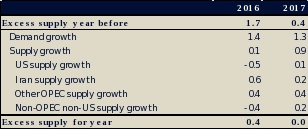Economic Commentary
Oil prices have had an eventful 2016. They started the year on a downward trend falling to a low of USD28/barrel (/b) in late January on concerns about slowing global growth and currency devaluation risk in China. Prices then recovered to around USD50/b by mid-year only to moderate to their year-to-date average of USD42/b. Given the stronger-than-expected rebalancing currently underway in the oil market, we have revised up our forecast and we currently expect prices to average USD44.7/b in 2016, up from our previous forecast of USD40.8/b. Beyond that, we expect the continued rebalancing in the oil market to lift prices to an average of USD55.0/b in 2017 (up from a previous forecast of USD51.3/b) and USD57.9/b in 2018 (up from USD56.0/b).
Brent crude oil price (USD/b)

Sources: Haver Analytics and QNB Economics forecasts
The rebalancing in the oil market has been stronger than expected. On the demand side, the International Energy Agency (IEA) currently expects global demand growth to reach 1.4m barrels per day (b/d) in 2016, up from their previous forecast of 1.2m b/d. The strong demand growth is driven by emerging markets, especially China and the rest of emerging Asia. Furthermore, demand from Europe is proving to be resilient despite increased uncertainty from the Brexit vote. The additional demand should help clear some of the excess supply in the market, estimated by the IEA to be 1.7m b/d in 2015.
Oil demand and supply changes (m b/d, annual average)

Sources: IEA and QNB Economics forecasts
On the supply side, high-cost oil producers in the US have been steadily reducing their output since April 2015. The IEA expects US production to fall by 0.5m b/d in 2016. But the supply adjustment has not been confined to the US. Other producers in non-OPEC countries such as China and Colombia are also forecast to reduce their output in 2016. Offsetting this is additional Iranian production following the lifting of sanctions in January. Other OPEC countries are also expected to increase their production this year as they compete for market share. Overall, the increase in supply is expected to be moderate and the over-supply in the market is expected to be reduced to 0.4m b/d by the strong demand growth, leading to oil prices averaging USD44.7/b in 2016.
In 2017, we expect the remaining moderate excess supply in the market to be completely eliminated despite higher supply from virtually all the major global producers. This is because the additional demand, expected to reach 1.3m b/d—near its long-term trend growth, should be enough to absorb all remaining and new supply. The completion of the rebalancing process should support higher oil prices, which we forecast to average USD55.0/b in 2017.
In the medium term, oil prices should be determined by the cost of the marginal producer, in this case US shale companies. Oil analysts currently estimate this cost to be USD60/b. We therefore expect a gradual convergence of oil prices to this level, leading to an average oil price of USD58.0/b in 2018.
In conclusion, while the shale revolution has been a game changer for oil, it has not changed its intrinsic nature as a market. When markets are over-supplied and prices fall, they tend to adjust through two channels. First, high-cost producers tend to exit the market as their businesses become unviable. Second, low prices encourage higher consumption which provide support to prices. These dynamics are currently underway in the oil market and are progressing in a manner that is faster than previously thought. This does not mean a return to a world in which oil prices exceeded USD100/b for several years, but a price of USD60/b is probably within range in the medium term.
